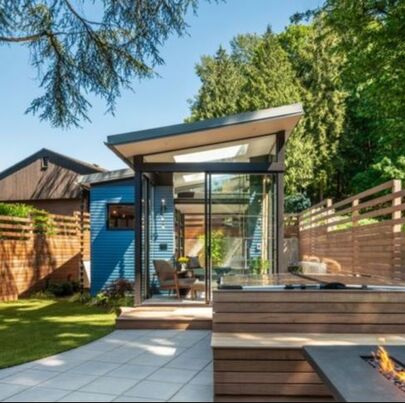[SPONSORED POST]

It’s not unusual to receive a call from new Buyers moving from San Francisco, Redwood City, Marin, or in some cases, towns and cities much further afield, looking to buy a home in the East Bay.
Comparatively, The East Bay is still viewed as highly affordable when placed against these much higher-priced communities (although Oakland’s median prices continue to rise).
Invariably, we get around to their “wish list,” which often goes like this: “We’d love a house near BART, in a good shopping district, with at least 3 bedrooms, 2 bathrooms and oh, a little cottage out back or extra space downstairs we can rent out for extra income would be great.” (Yes, it would.)
“What’s your price point?” I ask.
“We don’t want to spend more than $800,000, but could stretch a little if we need to.” (Uhhh, do I pop their balloon now or later?)
So would it surprise you to know that a property along these lines just sold in the Temescal for more than twice as much and received double-digit offers well above its list price of $1,050,000? In fact, it traded above $1,650,000. (Gulp!)
You wouldn’t be the first to want “a little extra income” or to be attracted to the concept of an ‘accessory dwelling unit’ (ADU) – they’re smart investments given the popularity of Airbnb, they provide flexible living space for aging parents or boomeranging children, and they may help offset your monthly mortgage as well. But before shelling out for these highly sought-after opportunities, you’ll want to check the city ordinances to confirm whether or not the municipality allows you to rent short-term at all. (Many municipalities do not, while others have strict restrictions, limitations or a line of homeowners out the door waiting to get a certificate to rent their ADUs on Airbnb.)
Let’s backup a minute and talk a little about the ADU and why they’re suddenly so popular. California, in its desire to create more affordable housing and to increase housing stock much faster than developers were delivering, overroad the restrictions and roadblocks local municipalities had put in place to discourage, or in many cases, eliminate altogether, the ability to add an ADU to a home. Unrealistic setbacks, additional off-street parking requirements and other ‘highly-restrictive’ rules made it impossible to comply; thus, pool houses, backyard outbuildings, overgrown sheds, and basements remained as they were, OR (perish the thought), were converted illegally. (That’s not recommended.)
However, on October 18, 2017, Governor Brown signed two separate bills that took effect on January 1, 2018, designed to specifically PROMOTE the development of ADUs, by opening areas where they can be built – including ALL residential districts (hello Piedmont) – allowing ADUs to be built concurrently with single-family houses, modifying utility fees, and reducing the parking requirements. In short, these new laws gave far more latitude and flexibility to homeowners and their land than ever before.
On Wednesday evening, I met my friend, Beth, in the city and attended a NARI meeting (National Association of the Remodeling Industry) to hear a panel of architects speak on the advancements and roadblocks with respect to ADUs. Here’s what they had to say (I’m paraphrasing to save you all two hours of your valuable time.You’re welcome.)
On the plus side, ADUs:
- Are incredibly flexible.
- May be approved with NO public notice or hearing (But NOT in SF!!!).
- Create in-law and au-pair units.
- May provide rental income.
- May offer short-term rental opportunities.
- Create instant equity.
- Offer the highest square-foot value one can add to their existing structure.
- Allow for independent living.
- Use available land and infrastructure.
- Can be carved out of the existing structure or can stand alone in the yard.
- Provide more affordable housing in many metro areas.
On the flip side, ADUs
- Are not a free pass; they require all the same safety measurements and building codes as the main house (light, egress, ceiling height, etc.).
- Are costly to build; the first 300 square feet require the same infrastructure as a 3000 square foot house, but is condensed into a much smaller package. (On average, an ADU can start at $200,000 and go up from there.)
- Cities still mandate any and everything the state did not outline in its laws.
- The requirements and restrictions change from city to city, as do the building codes.
- Must comply with city guidelines.
- Are designed to be small in nature, thus they typically max out under 1200 square feet (In Piedmont, the max is 800 sq’, In Oakland, 800 sq’, in Berkeley 850 sq’.).
- The roof may not exceed 14′.
- Come with deed restrictions, meaning the ADU can never be sold independently and an owner must either occupy the main house or the ADU.
- Are limited to one ADU per parcel (no family compounds).
- May not be built where a duplex already exists.
- Must provide a separate entrance.
- May not go in the front yard (that one seems entirely fair to me).
- Require a 4′ setback from all property lines.
What’s the process?
- Like with a home, you’ll meet with an architect to outline your goals, dreams and desires.
- Create a feasibility study understanding the local zoning restrictions.
- Outline the costs to build.
- Create schematic drawings.
- Turn them into the city planning department for review and comment.
- Often go in front of design review.
- Receive a building permit (the fee is typically 5-6% of the construction costs).
- Select a contractor/builder.
- Work with a designer to select windows, finishes, etc.
- Start construction and build!
Oh, and along the way, there will be a fair amount of wait time in between each of these steps and the finished product will certainly cost you more than the MASSIVE remodel Chip and Joanna Gains just finished in Waco Texas on HGTV. (California constructions costs are easily 50% more than anywhere else in the continental U.S., except NYC, according to the panel.)
Is this information meant to discourage you? Not at all. ADUs are still going to be far less expensive than an apartment, condominium, or assisted-living unit for an aging parent or a grown child, AND they do have the advantage of attracting more Buyers come time to sell. Plus, they’re incredibly flexible in a time when families are truly multi-generational and need solutions for housing on both ends of the spectrum. (Cliff’s mother is 93 and lives independently right below us in a beautiful garden apartment where we can check in on her daily.)
In fact, ADUs are so popular, some architects have now devoted their entire practice to these less-limiting structuresand entire ‘cottage’ industries (pun intended) have grown up around them. See Studio Sheds for Inspiration.
So if an ADU is high on your wish list, go for it. Just don’t expect to find one for a bargain. You’ll be in heavy competition come time to buy. On the other hand, an ADU ought to make your house that much more attractive come time to sell! You may count on it.
In the meantime…
How can I help you?

Julie Gardner | Compass Realty
(Not just a Realtor, but a consultant in all things house and home, I’m here to educate, explore, examine and refer . . . In short, you may count on me to take care of your home as if it were my own and anyone who knows me, knows I take pretty darn good care of my home.)
